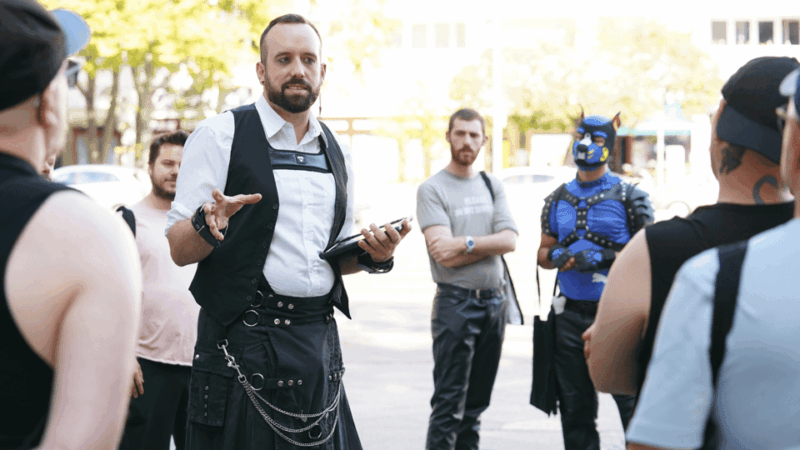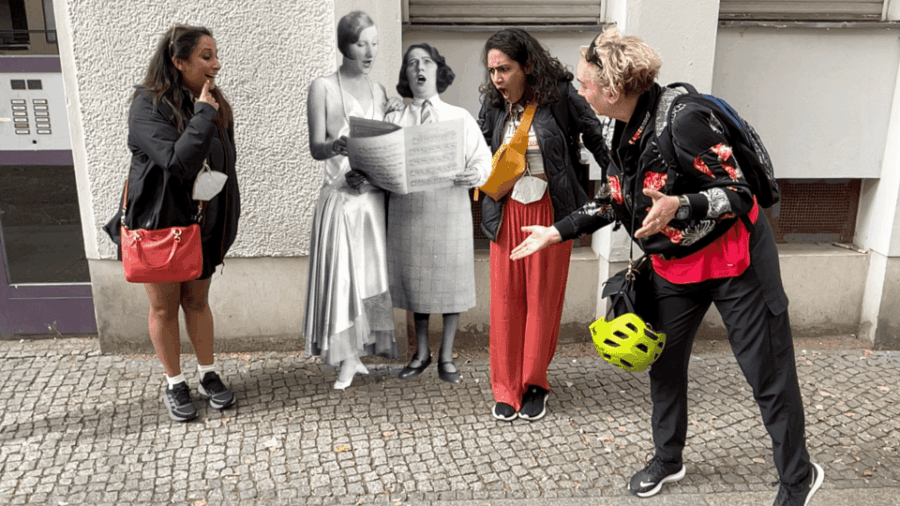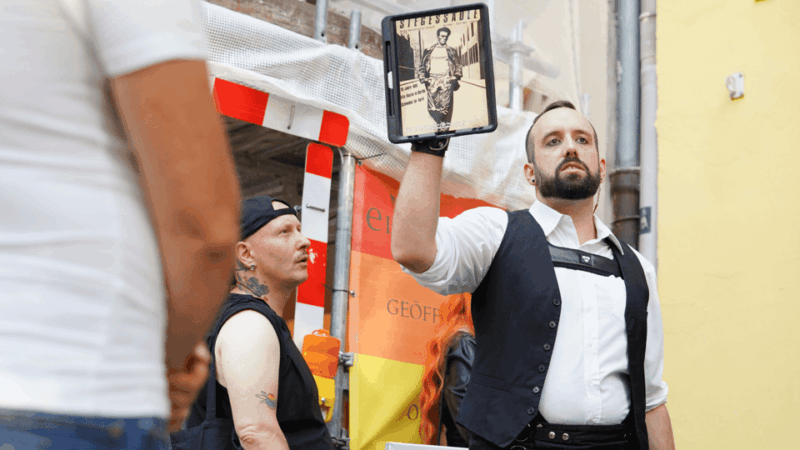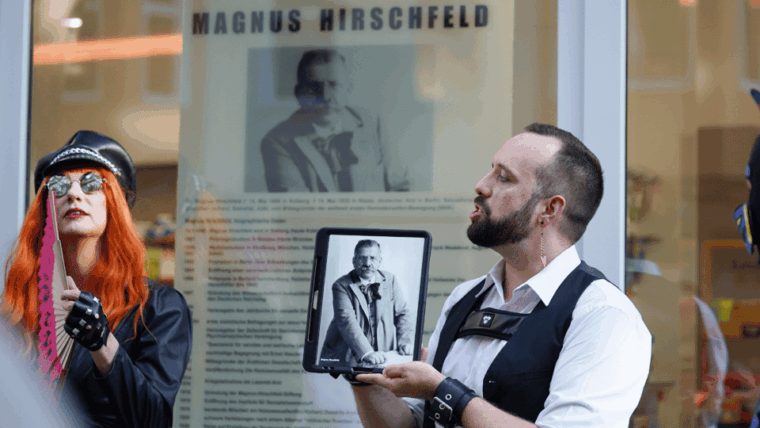Travelers curious about the roots of LGBTQIA+ culture and activism will find this Berlin tour a compelling journey through more than 150 years of queer resistance, nightlife, and societal change. Led by a passionate queer activist and gender scholar, this experience offers a balanced mix of storytelling, multimedia elements, and interactive moments that bring history vividly to life.
What sets this tour apart is its engaging multimedia approach—think historic photos, videos, rare audio clips, and augmented reality (AR) selfies. It’s a rare chance to connect deeply with Berlin’s vibrant queer past and its ongoing influence. However, the 3-hour duration and detailed historical content mean it’s best suited for those with a genuine interest in social history and activism.
Three aspects we particularly appreciate are the interactive AR features, which make history feel personal, the expert guide’s insights, sharing insider stories that books can’t, and the comprehensive scope—covering everything from early activism to nightlife and resistance under the Nazis. One possible consideration is that the tour includes sensitive topics like violence, discrimination, and persecution, so it’s best for those comfortable with such discussions.
This experience will appeal most to history buffs, LGBTQIA+ travelers, and locals wanting to reconnect with their city’s queer roots. It’s an educational, heartfelt tour that balances entertainment with meaningful stories.
Good To Know

- Authentic Experience: A multimedia journey through over 150 years of LGBTQIA+ history in Berlin.
- Expert-led: Guided by a queer activist and gender scholar, offering deep insights.
- Interactive Elements: AR selfies, quizzes, and immersive scenes make history engaging.
- Comprehensive Content: From early activists to nightlife, resistance, and societal shifts.
- Suitable for: LGBTQIA+ travelers, allies, history lovers, and locals.
- Accessibility: Wheelchair accessible route and subtitles are available, but some paths may be bumpy.
In-Depth Review of the Queer & Trans History Tour in Berlin

Interested in history? More Berlin historical sites we've covered
The Starting Point and Its Significance
The tour kicks off at Alnatura Super Natur Markt in Nollendorfplatz, a neighborhood historically central to Berlin’s LGBTQIA+ scene. Starting here provides an immediate sense of place—Nollendorfplatz is known as Berlin’s gay district, a vibrant hub that’s been pivotal for queer life for decades. Meeting at a well-known public spot simplifies logistics and sets a welcoming tone. The tour’s small group size (limited to 10 participants) ensures an intimate atmosphere where questions and conversations can flow naturally.
Walking Through History: Key Stops and Stories
Stop 1: Karl-Heinrich-Ulrichs-Straße — The tour’s first stop pays homage to Karl Heinrich Ulrichs, often called the first gay rights activist. We loved how the guide described Ulrichs’ pioneering work in the 19th century, emphasizing how he challenged societal norms long before the modern LGBTQ+ movement took shape. Expect a brief but impactful 10-minute walk-and-talk, with historical photos projected onto your phone or AR scenes that bring his story to life.
Stop 2: Hidden Gem — Though details are sparse, this part of the tour features a lesser-known site, perhaps a former queer social space or activist landmark. The guide’s storytelling here is rich, providing context that isn’t always documented in textbooks. This stop gives an authentic glimpse into everyday queer life in early 20th-century Berlin.
Stop 3: Schwerinstraße — A significant street in Berlin’s queer history, with a 15-minute stop. The narrative covers how Berlin became a haven for LGBTQIA+ expression in the roaring twenties, with underground drag clubs and cabarets thriving before the Nazi crackdown. Reviewers mention the guide’s lively recounting of Berlin’s legendary nightlife, from the 1920s to today.
Stop 4: Nollendorfstraße — A key location for lesbian bars and feminist activism. The guide highlights icons like Marlene Dietrich and Josephine Baker, illustrating how Berlin became a global center for queer and feminist resistance. Test your knowledge with quiz questions integrated into the tour—interactive quizzes are a fun element reviewers enjoy.
Stop 5: Magnus-Apotheke — A historic pharmacy connected to trans history and gender-affirming surgeries. The story here is particularly compelling, with insights into how trans identities were recognized and supported before the Nazi era, including the use of transvestite certificates. One reviewer notes, “It was eye-opening to learn about the early medical innovations supporting trans people—and how much was erased during Nazi persecution.”
Stop 6: Denns BioMarkt and Stop 7: Prinz Eisenherz — These are more recent sites, with a 15-20 minute focus on Berlin’s modern queer scene, including nightlife venues like SchwuZ nightclub, which became a hub for activism during the HIV/AIDS crisis. The guide shares stories of how the club scene evolved into a form of resistance and community-building.
Stop 8: Connection Club — A place historically known for queer nightlife, emphasizing the role of clubs in fostering activism and community. Reviewers mention that the guide’s personal stories about these venues make history feel alive.
Stop 9: Internationale Stele GEGEN DAS VERGESSEN — A memorial to those persecuted under the Nazi regime. The tour discusses how Nazi policies targeted queer people, with concentration camp stories that are difficult but crucial to understanding the ongoing fight for acceptance.
Stop 10: Metropol — The iconic club where many LGBTQIA+ icons performed, such as Marlene Dietrich and Romy Haag. The guide shares insider facts, making this part of the tour particularly memorable. The multimedia elements, including videos and AR scenes, really help to visualize this lively history.
The Multimedia and Interactive Experience
A standout feature of this tour is its use of over 200 archival photos, videos, and audio clips. These elements provide an immersive window into different eras—like hearing the voices of early activists or witnessing Berlin’s nightlife through historic footage.
AR selfies with figures like Magnus Hirschfeld allow participants to engage physically with the history, which many reviewers describe as a fun and memorable aspect. Interactive quizzes test your knowledge, keeping engagement high, and adding a playful competitive edge.
More Great Tours NearbyAccessibility and Practical Details
The tour is designed to be wheelchair accessible with some caveats about bumpy paths, and subtitles are provided for videos, making it inclusive for many participants. It’s held in English and limited to small groups, ensuring personalized attention.
The 3-hour length strikes a good balance—long enough to explore many stories but not exhausting. The cost of $63 per person is reasonable considering the depth of content and multimedia features provided. It’s a solid value, especially for those intensely interested in social history or LGBTQIA+ culture.
Review Insights and Real Stories
From reviews, it’s clear the guide, described as a queer activist and social scientist, is passionate and knowledgeable. One reviewer praised the guide’s storytelling style: “They kept the history engaging and relevant, weaving personal stories into bigger historical trends.” Another mentioned how the “interactive elements made the past feel personal and real,” which is exactly what makes this tour stand out.
A few reviewers noted that some parts may be sensitive or intense, such as discussions of Nazi persecution or the AIDS crisis. Those interested in lighter sightseeing might find certain topics heavy, but overall, the tone remains respectful and educational.
Final Thoughts: Who Is This Tour For?

This tour is perfect for anyone eager to understand Berlin’s LGBTQIA+ past beyond the superficial. It’s especially valuable for history enthusiasts, LGBTQIA+ travelers, and locals who want to celebrate and better understand their city’s queer heritage. The multimedia, interactive approach makes it suitable for a range of ages and backgrounds—just be prepared for some heavy topics if you’re sensitive.
If you’re looking for an authentic, insightful, and visually engaging way to explore Berlin’s queer history, this tour offers a compelling package. It’s a blend of storytelling, activism, and nightlife that highlights Berlin’s role as a pioneering city for LGBTQIA+ rights and culture.
FAQ

- What is the tour duration? It lasts approximately 3 hours, with starting times available depending on availability.
- How much does the tour cost? It’s priced at $63 per person, offering good value given the multimedia content and guided expertise.
- Is the tour suitable for all ages? It’s designed for adults and isn’t recommended for children under 18 due to sensitive topics.
- What languages are available? The tour is conducted in English, with videos including subtitles in German and English.
- Is the route accessible for wheelchair users? Yes, the route is wheelchair accessible, though some paths may be bumpy.
- What should I bring? Wear comfortable clothes suitable for walking and weather conditions.
- Does the tour include any multimedia features? Yes, you’ll see over 200 photos, videos, and audio clips, plus AR selfies and digital recreations.
- Can I cancel if my plans change? Yes, free cancellation is available up to 24 hours in advance.
- Are there any physical or sensory considerations? Some areas may be loud or brightly lit; accommodations can be made for visual disabilities upon request.
- What kind of topics are discussed? The tour covers history including activism, Nazi persecution, the AIDS crisis, nightlife, and queer resistance, with some sensitive content.
This Berlin LGBTQIA+ history tour offers a rare blend of storytelling, multimedia, and activism, making it an ideal choice for those wanting to connect deeply with queer history. The interactive AR features and expert guide help make complex stories relatable and memorable.
While it’s not suited for children or those sensitive to certain topics, adults interested in social justice, history, or Berlin’s queer scene will find this experience both enriching and entertaining. It balances educational depth with fun, making it well worth the $63 price tag for a meaningful cultural exploration.
If you’re visiting Berlin and want to understand its queer roots firsthand, this tour is a prime pick—informative, engaging, and full of stories you won’t find in standard guidebooks.
You can check availability for your dates here: More Great Tours NearbyMore Historical Tours in Berlin
- Berlin: 1h Boutiquestyle-Cruise on the Historic HEMINGWAY
- Berlin Beers & Battlefields Tour: War History & German Beer
- Berlin: Ephraim-Palais: Guided tour of Berlin’s city history
- Berlin: Family tour of Berlin’s history and stories at the Ephraim Palace Museum
- Berlin: history walk – sightseeing walk in english
- Berlin: Historical Walking Tour with Live Music
More Tours in Berlin
- “Festival of lights” Rickshaws Tour Start Brandenburger Tor
- Alternative tour of Berlin in Spanish
- Berlin: 2-Hour Christmas Lights Bus Tour incl. Mulled Wine
- Berlin: 1-Hour Boat Tour with Bilingual Guide (Ger/Eng)
- Berlin: Alternative & Street Art Tour
- Berlin: 3.5-hour bike tour A journey through time in the capital
More Tour Reviews in Berlin
- “Festival of lights” Rickshaws Tour Start Brandenburger Tor
- Illuminiertes Berlin: Lichterfahrt mit Livekommentar
- 3 Days Private Guide Berlin By Walking and Public Transport
- Alternative tour of Berlin in Spanish
- Berlin: 2.5-Hour Beer & Sunset Sightseeing Boat Cruise
- Berlin: 2-Hour Christmas Lights Bus Tour incl. Mulled Wine
Looking for something different? Other Berlin activities we've written about
- “Festival of lights” Rickshaws Tour Start Brandenburger Tor
- Illuminiertes Berlin: Lichterfahrt mit Livekommentar
- 3 Days Private Guide Berlin By Walking and Public Transport
- Alternative tour of Berlin in Spanish
- Berlin: 2.5-Hour Beer & Sunset Sightseeing Boat Cruise
- Berlin: 2-Hour Christmas Lights Bus Tour incl. Mulled Wine
- Berlin: 1h Boutiquestyle-Cruise on the Historic HEMINGWAY
- Berlin: 1-hour Highlights River Cruise Through Old and New
- Berlin: 1h Boutiquestyle-Cruise on the Electric FITZGERALD
- Berlin: 1-Hour Boat Tour with Bilingual Guide (Ger/Eng)
- Berlin: All Inclusive WelcomeCard & Transportation Zones ABC
- Berlin: “90s Forever – Hits & Acrobatics” – Varieté Show
